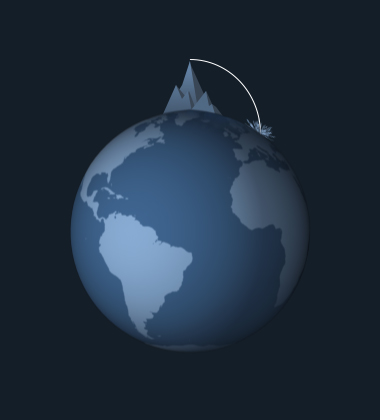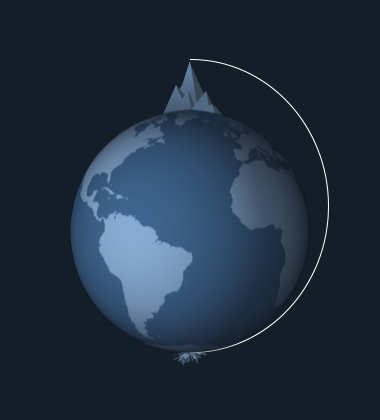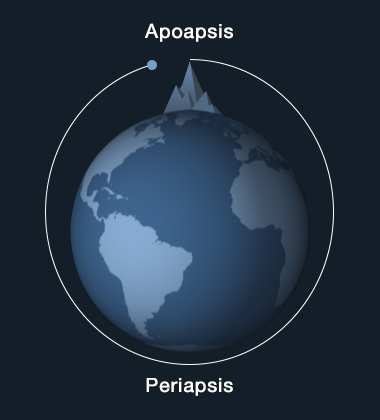Orbital Mechanics How Things Works
Orbital Mechanics How Things Works
Gravity & Mechanics
How Orbits Work
These drawings simplify the physics of orbital mechanics, making it easy to grasp some of the basic concepts. We see Earth with a ridiculously tall mountain rising from it. The mountain, as Isaac Newton first described, has a cannon at its summit.
Of course, in order to make their point, the cartoons on this page ignore lots of facts, such as the impossibility of there being such a high mountain on Earth, the drag exerted by the Earth's atmosphere on the cannonball, and the energy a cannon can impart to a projectile ... not to mention how hard it would be for climbers to carry everything up such a high mountain! Nevertheless, the orbital mechanics they illustrate (in the absence of details like atmosphere) are valid.
When the cannon is fired, the cannonball follows its ballistic arc, falling as a result of Earth's gravity, and of course it hits Earth some distance away from the mountain.
If we pack more gunpowder into the cannon, the next time it's fired, the cannonball goes faster and farther away from the mountain, meanwhile falling to Earth at the same rate as it did before. The result is that it has gone halfway around the cartoon planet before it hits the ground. (You might enjoy the more elaborate animation at Space Place.)
Packing still more gunpowder into the capable cannon, the cannonball goes much faster, and so much farther that it just never has a chance to touch down. All the while it would be falling to Earth at the same rate as it did in the previous cartoons. This time it falls completely around Earth! We can say it has achieved orbit.
That cannonball would skim past the south pole, and climb right back up to the same altitude from which it was fired, just like the cartoon shows. Its orbit is an ellipse.
This is basically how a spacecraft achieves orbit. It gets an initial boost from a rocket, and then simply falls for the rest of its orbital life. Modern spacecraft are more capable than cannonballs, and they have rocket thrusters that permit the occasional adjustment in orbit, as described below. Apart from any such rocket engine burns, they're just falling. Launched in 1958 and long silent, the Vanguard-1 Satellite is still falling around Earth.
In the third cartoon, you'll see that part of the orbit comes closer to Earth's surface than the rest of it does. This is called the periapsis of the orbit. The mountain represents the highest point in the orbit. That's called the apoapsis. The altitude affects the time an orbit takes, called the orbit period. The period of the space shuttle's orbit, at say 200 kilometers, used to be about 90 minutes. Vanguard-1, by the way, has an orbital period of 134.2 minutes, with its periapsis altitude of 654 km, and apoapsis altitude of 3,969 km.
The Key to Space Flight
Basically all of space flight involves the following concept, whether orbiting a planet or travelling among the planets while orbiting the Sun.
As you watch the third cartoon's animation, imagine that the cannon has been packed with still more gunpowder, sending the cannonball out a little faster. With this extra energy, the cannonball would miss Earth's surface at periapsis by a greater margin, right?
Right. By applying more energy at apoapsis, you have raised the periapsis altitude.
A spacecraft's periapsis altitude can be raised by increasing the spacecraft's energy at apoapsis.
This can be accomplished by firing on-board rocket thrusters when at apoapsis.
And of course, as seen in these cartoons, the opposite is true: if you decrease energy when you're at apoapsis, you'll lower the periapsis altitude. In the cartoon, that's less gunpowder, where the middle graphic shows periapsis low enough to impact the surface. In the next chapter you'll see how this key enables flight from one planet to another.
Now suppose you increase speed when you're at periapsis, by firing an onboard rocket. What would happen to the cannonball in the third cartoon?
Just as you suspect, it will cause the apoapsis altitude to increase. The cannonball would climb to a higher altitude and clear that annoying mountain at apoapsis.
A spacecraft's apoapsis altitude can be raised by increasing the spacecraft's energy at periapsis.
This can be accomplished by firing on-board rocket thrusters when at periapsis.
And its opposite is true, too: decreasing energy at periapsis will lower the apoapsis altitude. Imagine the cannonball skimming through the tops of some trees as it flys through periapsis. This slowing effect would rob energy from the cannonball, and it could not continue to climb to quite as high an apoapsis altitude as before.
In practice, you can remove energy from a spacecraft's orbit at periapsis by firing the onboard rocket thrusters there and using up more propellant, or by intentionally and carefully dipping into the planet's atmosphere to use frictional drag. The latter is called aerobraking, a technique used at Venus and at Mars that conserves rocket propellant.
Orbiting a Real Planet
Isaac Newton's cannonball is really a pretty good analogy. It makes it clear that to get a spacecraft into orbit, you need to raise it up and accelerate it until it is going so fast that as it falls, it falls completely around the planet.
In practical terms, you don't generally want to be less than about 150 kilometers above surface of Earth. At that altitude, the atmosphere is so thin that it doesn't present much frictional drag to slow you down. You need your rocket to speed the spacecraft to the neighborhood of 30,000 km/hr (about 19,000 mph). Once you've done that, your spacecraft will continue falling around Earth. No more propulsion is necessary, except for occasional minor adjustments. It can remain in orbit for months or years before the presence of the thin upper atmosphere causes the orbit to degrade. These same mechanical concepts (but different numbers for altitude and speed) apply whether you're talking about orbiting Earth, Venus, Mars, the Moon, the sun, or anything.
A Periapsis by Any Other Name
Periapsis and apoapsis are generic terms. The prefixes "peri-" and "ap-" are commonly applied to the Greek or Roman names of the bodies which are being orbited. For example, look for perigee and apogee at Earth, perijove and apojove at Jupiter, periselene and apselene or perilune and apolune in lunar orbit, pericrone and apocrone if you're orbiting Saturn, and perihelion and aphelion if you're orbiting the sun, and so on.
Freefall
If you ride along with an orbiting spacecraft, you feel as if you are falling, as in fact you are. The condition is properly called free fall. You find yourself falling at the same rate as the spacecraft, which would appear to be floating there (falling) beside you, or around you if you're aboard the International Space Station. You'd just never hit the ground.
Notice that an orbiting spacecraft has not escaped Earth's gravity, which is very much present -- it is giving the mass the centripetal acceleration it needs to stay in orbit. It just happens to be balanced out by the speed that the rocket provided when it placed the spacecraft in orbit. Yes, gravity is a little weaker on orbit, simply because you're farther from Earth's center, but it's mostly there. So terms like "weightless" and "micro gravity" have to be taken with a grain of salt... gravity is still dominant, but some of its familiar effects are not apparent on orbit.



















Comments
Post a Comment